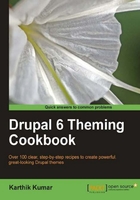
Drupal themes can consist of a multitude of files each with its own purpose, format, and syntax. This recipe will introduce each of these types with an explanation of what they do.
It will be useful to navigate to the Garland folder at themes/garland to browse and view the files inside a typical, fully featured theme. Garland also uses the PHPTemplate theming engine which is the most commonly used and recommended engine across Drupal's core and contributed themes.
The following table outlines the types of files typically found inside a theme's folder and the naming conventions to be followed for some of them.
Type Mandatory? Descriptionmytheme.infoYes Configuration file which provides information to Drupal about a theme named mytheme.page.tpl.phpYes A template file which determines the layout of all Drupal pages.node.tpl.phpNo A template file which determines the layout of a node inside a Drupal page.block.tpl.phpNo A template file which determines the layout of a block.*.tpl.phpNo Other template files which allow the customization and styling of themable aspects of Drupal.style.cssNo CSS stylesheet—if this file exists, it will be automatically included in the theme.script.jsNo Javascript file—if this file exists, it will be automatically included in the theme.*.jsNo Other Javascript files which will need to be explicitly included in the.infofile.favicon.icoNo Shortcut icon—if this file exists, it will be automatically included in the theme unless overridden from within Drupal.logo.pngNo Site logo—if this file exists, it will be automatically included in the theme unless overridden from within Drupal.screenshot.pngNo Theme preview image—if this file exists, it will be automatically included in the theme.template.phpNo PHPTemplate master file where some of the more complicated and powerful tweaks and overrides occur.
Perusing the contents of each of the available files will prove very useful as we go along developing our theme.
When a theme is added, Drupal first parses its .info file. This file, as its extension suggests, provides information about the theme such as its name, Drupal version compatibility, regions declared, CSS stylesheets used, JavaScript files included, and so on. In other words, Drupal uses it to find out the configuration and features of a theme.
The .info file also specifies the theming engine being used by the theme which, by default, is PHPTemplate. Theme engines allow theme developers to communicate with Drupal using a simpler and more convenient interface commonly via template files. A number of them also introduce their own language formats for use in these template files.
Template files in PHPTemplate themes are those that use the .tpl.php extension. Unlike other engines, these files just use PHP and HTML and do not rely on any special markup languages.
Other theme engines besides PHPTemplate are also available. However, only a handful of themes in Drupal's contribution repository rely on them.
The PHPTemplate engine is the most widely prevalent theming engine used in the Drupal ecosystem and is a part of the Drupal core package. Themes using other engines such as Smarty or Xtemplate are rare and will be structured quite differently. A list of engines can be found at http://drupal.org/project/Theme+engines.